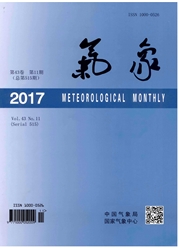

 中文摘要:
中文摘要:
利用NOAA最优插值逐日海表温度(SST)资料和NCEP/NCAR的逐日大气再分析资料,本文分析了黑潮延伸体区域海表温度锋的变化对北太平洋风暴轴的影响。结果表明,黑潮延伸体区域海表温度锋位置的季节变化很弱,而其强度的变化则非常显著,北太平洋风暴轴强度与海表温度锋强度具有一致的协同变化。冬季黑潮延伸体区域海表温度锋强度最强,增强了其上空大气的斜压性,从平均有效位能向涡动有效位能的斜压能量转换以及从涡动有效位能向涡动动能的斜压能量转换均在黑潮延伸体区域显著增加,斜压涡旋在此区域生成更加频繁,在随西风向下游运动过程中不断从背景平均流中获得能量,从而导致北太平洋风暴轴增强,且将其中心轴线固定在黑潮延伸体区域上空,而夏季黑潮延伸体区域海表温度锋强度非常弱,其上空大气斜压性减弱,从平均有效位能向涡动有效位能的斜压能量转换以及从涡动有效位能向涡动动能的斜压能量转换均显著减少,斜压涡旋在此区域生成减少,导致北太平洋风暴轴减弱,且中心移至太平洋中部,位置偏北。
 英文摘要:
英文摘要:
By using NOAA daily optimum interpolation sea surface temperature (SST) data and NCEP/ NCAR daily atmospheric reanalysis data, this paper analyzes the seasonal variation of Kuroshio Extension SST front and its influence on the Pacific storm track. The results show that the seasonal variation of the SST front position is weak, but its strength has significantly strong seasonal variation, and the strength of Pacific storm track has a coordinated change with the strength of SST front in Kuroshio Extension. The SST front is the strongest in winter, enhancing the baroclinicity of the atmosphere above it. The baroclinic energy conversions from mean available potential energy to eddy available potential energy and from eddy available potential energy to eddy kinetic energy are increased in the Kuroshio Extension region, where the baroclinic eddies are generated more frequently, absorbing energy from the background mean flow during the process of moving downward along with west wind, and, finally, strengthening the Pacific storm track and anchoring the central axis of the storm track above the Kuroshio Extension region. The SST front is very weak in summer, weakening the baroclinicity of the atmosphere above. The baroclinie energy conver- sions from mean available potential energy to eddy available potential energy and from eddy available potential energy to eddy kinetic energy are greatly reduced, and baroclinic eddies are generated less frequently, weakening the Pacific storm track, and making the strength center move to central Pacific, located northward.
 同期刊论文项目
同期刊论文项目
 同项目期刊论文
同项目期刊论文
 期刊信息
期刊信息
